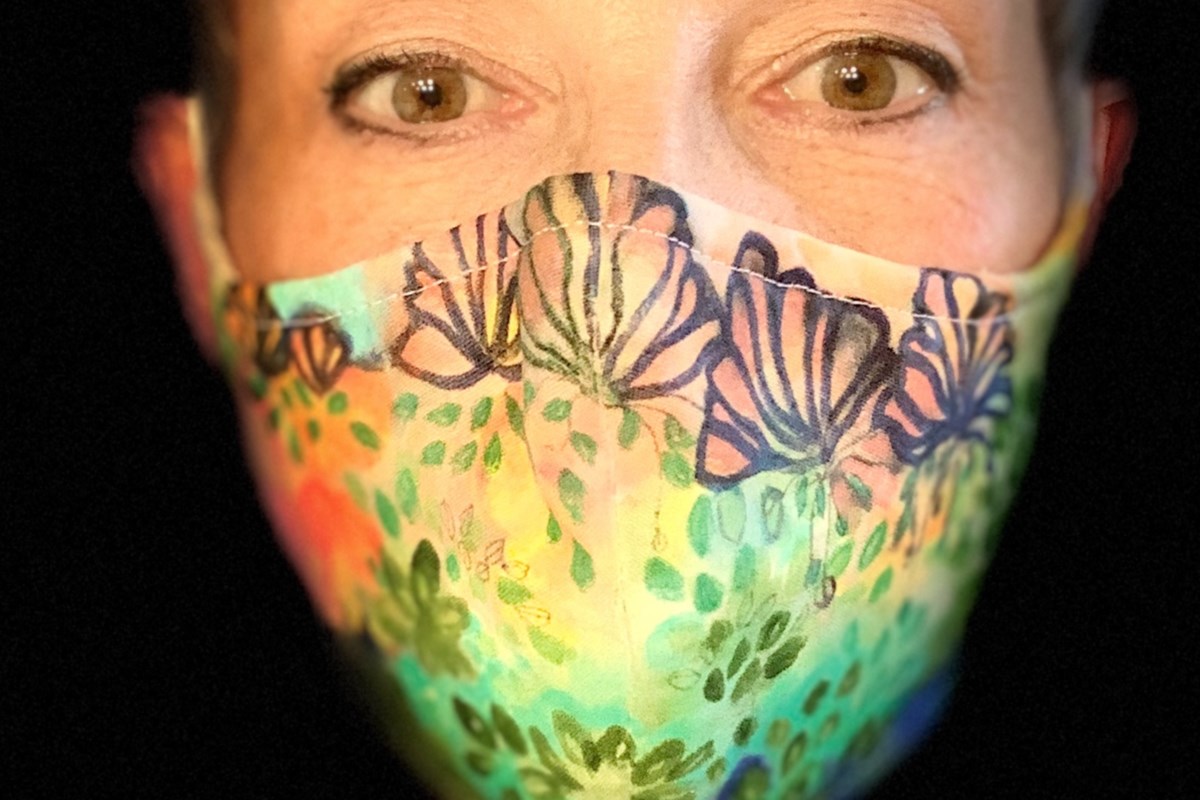It is becoming an everyday fashion accessory, a part of many wardrobes and now, it is being turned into a work of art and a representation of self expression.
Local visual artist Sharyn Seibert has embraced this new canvas: face masks.
“Dostoevsky said that beauty will save the world. As artists, we are always trying to find the meaning in what we are doing,” Seibert says.
“Especially during this time, there has to be room for spirituality, something bigger than ourselves. I think this is the purpose art serves. Whether it’s music, theatre, architecture or any of the arts.”
During the pandemic, Seibert says she continues to create and with each new work comes a new journey and a new challenge.
Incorporating creative artistic interpretations into face mask design is one of them.
“At the beginning of the pandemic, I had a show on and artwork in four different places which were all locked down. My daughter, who is a midwife in B.C., said that they didn’t have enough PPE. So, I thought, well I have cotton, I will do it myself. I made masks and painted them,” she said.
“It’s funny because I was already stockpiling fabric paint. This was an opportunity and then it just skyrocketed.”
Seibert also donated masks to families visiting loved ones and others receiving medical treatments including cancer patients.
“People saw the masks online and many commented saying how great they were. But then people said they wanted to buy the masks,” Seibert says.
“I made over 100 and they are all very different and unique. Each one takes hours and hours to make.”
After the long process of purchasing fabric, washing, cutting, stapling, painting and sewing, voila, a new mask!
The end result?
A breathable and adjustable design, a work of art, a colourful creation to help brighten and maybe offer some inspiration for those who wear it during these uncertain times.
“I have sent masks all over including the U.S., to Texas, New Jersey and Long Island. I’ve even had repeat customers as well.”
In Guelph, Seibert gift wraps each mask. They are hung on a tree outside her home.
“People come and just pick their mask off the tree. It is all done safely,” she says.
Seibert, a retired teacher, has a background in art and art history. She has studied fine art in Canada and internationally at the Angel Academy of Art in Florence, Italy. She has also earned a welding ticket and a diploma in interior decorating.
In the past, Seibert ran a fabric design studio.
“So, it’s like everything has gone full circle,” she said.
In addition, Seibert and her husband Brian organize art tours to Italy. Seibert takes great joy in teaching and mentoring students along their travels.
But due to the pandemic, tours have been put on hold.
This, however, has meant more time for Seibert to explore new creative outlets.
“I have been experimenting with black and white and this is new to me,” Seibert says.
As she prepares for a show at the Bookshelf in April, a new outdoor art studio is also in the works at her home which will offer a panoramic view of the wonderful nature around her.
“Beauty in the community is healing. I love painting nature,” she said.
“It’s very meditative, it’s a form of escape and you can’t think of anything else while doing it.”
For Seibert, art is a vehicle offering insights into knowing oneself and knowing others.
“Many people talk to me about having a creative urge and then they don’t fulfil it. I think it is our destiny to be creative whether it’s cooking or gardening,” Seibert said.
“When there isn’t an avenue for creativity, people can become stifled in their spirit. If people have tools, skills and opportunities, they can be creative, and this is so important in this technological age.”
During the pandemic, Seibert encourages others to get creative as well.
“It’s a great stress reliever. Art is good for you. Don’t be afraid of it. It’s yours, your very own expression,” she says.
Seibert also says people shouldn’t be afraid to experiment with other media such as charcoal, pencil crayons or clay.
The pandemic has led Seibert to make an interesting switch from colourful paintings to black and white landscapes. Today, she can include face masks in her repertoire.
“People love all of the added colour when wearing the masks. Making them has been a real joy for me,” Seibert said.
“I hope people feel that when they wear them.”
Seibert’s artwork can be seen on Facebook and Instagram and at sharynseibert.com.
Source:- GuelphToday
Source link
Related

























